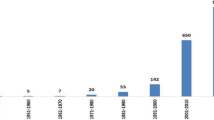Abstract
This article explores the concentration in the global plant molecular life science research output. In the past 15 years, especially the share of articles which refer to the model organism A. thaliana has increased rapidly. Citation analyses show an even greater rise in the importance of this organism. Attempts are discussed to come to a scientometric definition of model organisms. For this purpose a comparison is made with applied microbiology. However, few shared scientometric characteristics were found which could help characterise model organisms. A distinction between major economic organisms and model organisms will therefore continue to rely on qualitative data.




Similar content being viewed by others
References
FAO. (2004). The state of food and agriculture 2003–2004 agricultural biotechnology, meeting the needs of the poor? Rome: Food and Agriculture Organization of the United Nations.
Feldmann, K. A., & Marks, M. D. (1987). Agrobacterium-mediated transformation of germinating seeds of Arabidopsis thaliana: a non-tissue culture approach. Molecular and General Genetics, 208(1–2), 1–9.
Garfield, E. (1990). Keywords plus: ISI’s breakthrough retrieval method. Part 1. Expanding your searching power on current contents on diskette. Essays of an information scientist: Journalology, keywords plus and other essays, Vol. 13, p. 295; Current Contents, 32, pp. 3–7
Garfield, E., & Sher, I. H. (1993). Keywords plusTMalgorithmic derivative indexing. Journal of the American Society for Information Science, 44(5), 298–299.
GENOSCOPE 2008, Oryza sativa, The rice genome, a “Rosetta Stone” for other cereals. Retrieved November 2008 from http://www.genoscope.cns.fr/spip/Oryza-sativa-Rosetta-stone-for.html
Hedges, S. B. (2002). The origin and evolution of model organisms. Nature Reviews Genetics, 3, 838–849.
Jonkers, K., & Tijssen, R. (2008). Chinese researchers returning home: Impact of international mobility on research collaboration and scientific productivity. Scientometrics, 77(2), 309–333.
Leonelli, S. (2007). Growing weed, producing knowledge. A epistemic history of Arabidopsis thaliana. History & Philosophy of the Life Sciences, 29(2), 193–223.
Leydesdorff, L. (2007). Visualization of the citation impact environments of scientific journals: An online mapping exercise. Journal of the American Society for Information Science and Technology, 58(1), 25–38.
MAIZEGDB. Maize genetics and genomics database. Retrieved November 2008 from http://www.maizegdb.org/
MAIZESEQUENCE. Retrieved November 2008 from http://maizesequence.org/index.html last updated October 2008.
Moed, H. F., De Bruin, R. E., & Van Leeuwen, T. N. (1995). New bibliometric tools for the assessment of national research performance: Database description, overview of indicators and first applications. Scientometrics, 33(3), 381–422.
Naylor, R. L., Falcon, W. P., Goodman, R. M., Jahn, M. M., Sengooba, T., Tefera, H., et al. (2004). Biotechnology in the developing world: A case for increased investments in orphan crops. Food Policy, 29(1), 15–44.
Nelson, R. J., Naylor, R. J., & Jahn, M. M. (2004). The role of genomics research in improvement of “orphan” crops. Crop Science, 44, 1901–1904.
Normile, D. (1999). Rice biotechnology: Rockefeller to end network after 15 years of success. Science, 286(5444), 1468–1469.
O’Toole, JC., Toenniessen, G. H., Murashige, T., Harris, R. R., Herdt, R. W. (2000, 22–27 October). The Rockefeller Foundation’s international program on rice biotechnology. In Proceedings of the fourth international rice genetics symposium (pp. 39–59). Los Baños, Laguna, Philippines
Rockefeller Foundation. (2007). Alliance for a green revolution in Africa Retrieved November 2008 from http://www.rockfound.org/about_us/news/2007/0919agra_pr.shtml
Somerville, C. & Dangl, J. (2000). Plant biology in 2010. Science, 290(5499), 2077–2078.
Stokes, D. E. (1997). Pasteur’s quadrant: Basic science and technological innovation. Washington: Brookings Institution Press.
TAIR, About Arabidopsis. Retrieved November 2008 from http://www.arabidopsis.org/portals/education/aboutarabidopsis.jsp#hist
Twyman, R. (2002). What are ‘model organisms’? Retrieved November 2008 from http://genome.wellcome.ac.uk/doc_WTD020803.html
Author information
Authors and Affiliations
Corresponding author
Rights and permissions
About this article
Cite this article
Jonkers, K. Models and orphans; concentration of the plant molecular life science research agenda. Scientometrics 83, 167–179 (2010). https://doi.org/10.1007/s11192-009-0024-z
Received:
Accepted:
Published:
Issue Date:
DOI: https://doi.org/10.1007/s11192-009-0024-z




